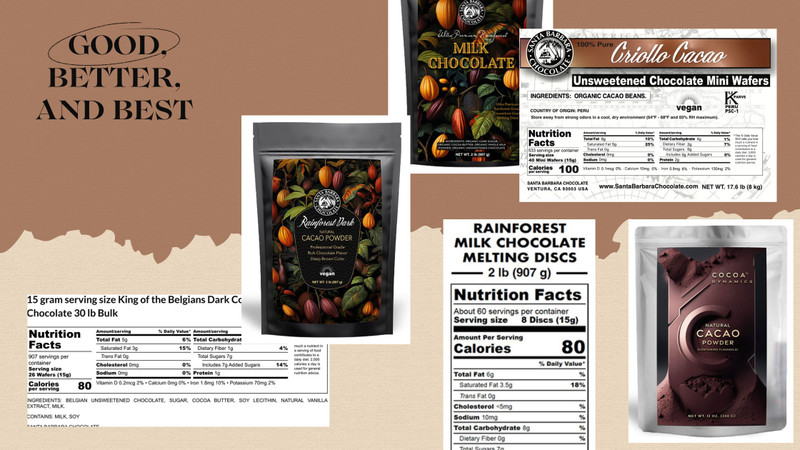When shopping for chocolate reading the labels can help you find the chocolate quality, source, and nutrition. This knowledge is important for the right chocolate, you want a sweet treat or a healthier option. Look for information on the chocolate ingredients label about the ingredients and how much cocoa is in the chocolate. Higher cocoa content usually means better quality. Also, check for any added sugars and artificial chocolate ingredients. These details can help you to make better choices and enjoy chocolate more. This guide will help you recognize good, better, and best chocolate options to feel good about what you buy.
Breaking Down a Chocolate Nutrition Label
A chocolate nutrition label provides a wealth of information, offering clues about the chocolate's quality. Let’s take a look: Cacao Fruit Chocolate: Dark Chocolate 72% sweetened by Cacao Pods.
- Calories and Serving Size: This chocolate label shows how much you should eat in one sitting. The calorie count tells you how much energy that portion provides. Usually, smaller serving sizes with moderate calorie counts indicate a richer and more concentrated product, suggesting better quality. When you compare chocolate labels, keep these points in mind to help you make a good choice. This will guide you toward healthier options.
- Fats, Sugars, and Fiber: The levels of fats and sugars can show you the quality of chocolate. High-quality chocolate usually has healthy fats from cocoa butter and lower added sugars. You should also look for higher fiber content because it means the chocolate contains more cocoa solids. Very sugary chocolates often fall into the "good" category, but those with less sugar and more fiber are often considered "better" or "best." Choose wisely for a tastier treat.
- Protein and Minerals: Protein, iron, and other minerals - magnesium and potassium can improve the chocolate's nutritional profile. Chocolate isn’t primarily a protein source, its mineral content in dark chocolate can offer health benefits. Iron contributes to oxygen transport in the body which can be an advantage for health-conscious consumers.
Key Chocolate Ingredients to Look for on A Label
When it comes to chocolate ingredients labels, fewer and more natural components typically indicate a higher-quality product. Unsweetened chocolate and dry cacao fruit juice concentrate from our featured chocolate bar. These are natural, minimally processed ingredients that contribute to the rich taste and health benefits of quality chocolate.
Conversely, if the label lists artificial flavorings, palm oil, or excessive sugars, it may indicate lower-quality chocolate. Look for terms like "cacao nibs" or "natural vanilla" instead of "vanillin" to identify better or best options.
Cocoa Percentage: Why It Matters
The percentage shows how much cocoa solids are in a chocolate bar. Our chocolate contains dark chocolate 72 percent a balance of richness and health benefits.
Higher Cocoa Percentage: Chocolates with a cocoa percentage above 70% tend to offer deeper flavors and fewer added sugars. For many higher percentages 80% or more can be a sign of a more premium product, though it may not appeal to everyone’s taste preferences. It's important to find a balance that suits your palate while also considering the health benefits.
Cocoa percentages lower than 50% are sweetened with large amounts of sugar placing them in the "good" category, while higher percentages lean towards "better" or "best" chocolate.
Importance of Chocolate Origin and Bean-to-Bar Practices
The chocolate origin is important for its flavor and ethics. The place where cacao beans grow can change the taste. Single-origin chocolates use beans from a specific region or farm giving unique flavors. These chocolates provide more information about where the beans come from. You can enjoy great taste and make responsible choices by choosing single-origin chocolate.
Chocolate Origin: A label with the cacao bean origin is a positive sign. Chocolate labels showing the beans come from regions like Ecuador, Ghana, or Madagascar. This is a more transparent supply chain and refined flavor.
Bean-to-Bar Chocolate: Makers control from buying cacao beans to producing the final chocolate. This method shows a hands-on approach, allowing for better quality control. Chocolate lovers usually connect this process to high-quality products, as it focuses on attention to detail and the overall chocolate experience.
Certifications and Tags on Chocolate Labels
Certifications and chocolate tags can tell you a lot about the product's ethical and environmental impact. Tags like Fair Trade, Organic, or Rainforest Alliance are common indicators that the chocolate is made with sustainability and ethical labor practices. These are often part of chocolate labeling requirements for brands that want to highlight their ethical standards.
- Fair Trade: A Fair Trade tag means, the cacao farmers were paid fair wages and worked in better conditions. This is often a good sign that a chocolate bar prioritizes people and quality.
- Organic: Organic certification, the cacao was raised without synthetic pesticides or fertilizers which is better for the environment and reflects dedication to natural chocolate ingredients.
- Rainforest Alliance: This focuses on sustainability. Ensures cacao is grown to protect nature and help farmers earn a better living.
Paying attention to these chocolate tags helps consumers identify brands that are focused on ethical production, which is often a hallmark of better and best-quality chocolate.
Conclusion
Reading chocolate nutrition labels helps chocolate lovers make better choices. Check the chocolate ingredients label, the cocoa percentage, and the chocolate's origin to learn more about its quality. This helps you make better choices when buying chocolate. Fair Trade or Organic Certificates, clear labels can help you choose the best chocolate. This knowledge helps you make smarter choices when buying chocolate.
As you become more familiar with labels and the significance of what they reveal, you'll feel more confident in your ability to select the highest-quality, ethically produced chocolate. Whether you are looking for a perfect sweet treat or aiming to follow chocolate labeling requirements for health and sustainability, careful attention to labels will guide you toward better and best chocolate options.


